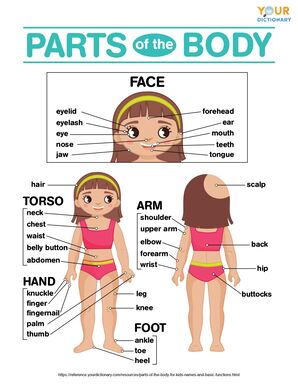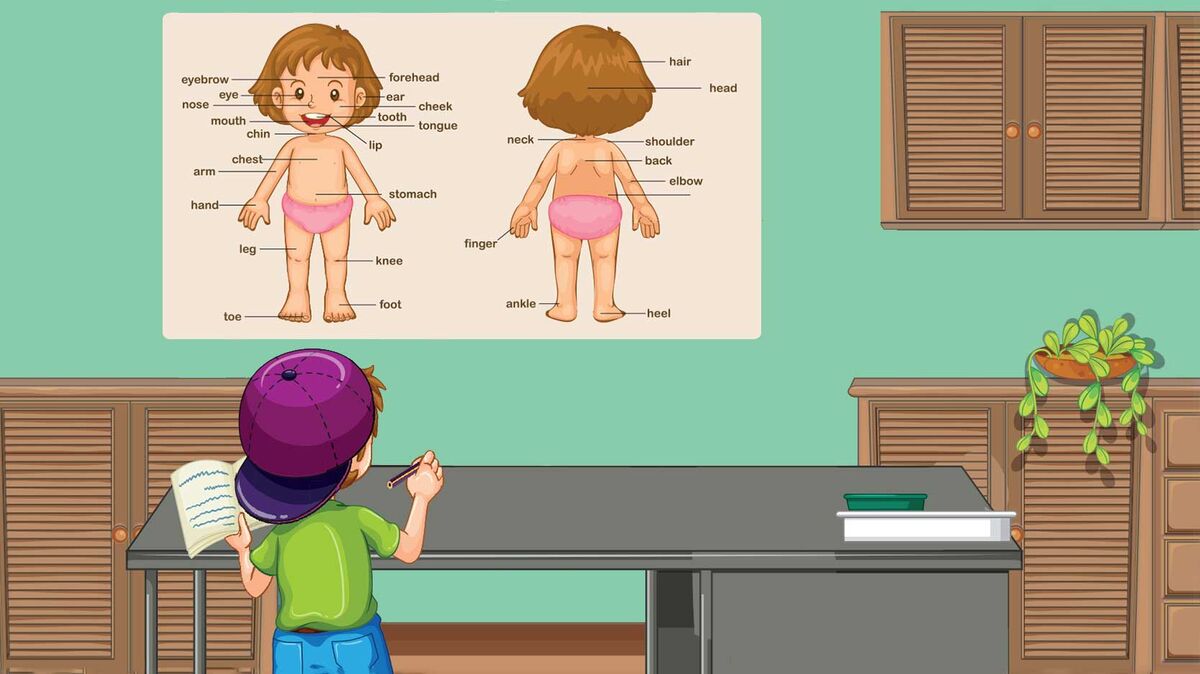

You know your head, shoulders, knees, and toes, but what are the other important body parts? Each large part of the body includes smaller body parts, which have different functions. Keep reading to learn body part names and basic functions of the parts of the body.
Diagram of Body Parts
External, which means “outside,” describes the body parts that you can see. Take a look at a helpful diagram that labels major external body parts. Download the printable PDF to see it in more detail and print if needed.

Parts of the Head and Neck
You can’t see all the parts of your head without a mirror, because your eyes are on your head too! Take a look at the external parts of the head, what they do, and where they’re located.
Body Part | Location | Functions |
face | front of the head | five senses; communicating emotions |
scalp | top of the head (under hair) | cooling the head with sweat glands in the skin; protecting the skull with extra blood vessels |
forehead | top of the face, above the eyes | forming facial expressions; protecting the eyes |
neck | below the head, above the shoulders | supporting the head’s weight; allowing the head to turn; sending messages from the brain to the rest of the body (vertebrae) |
eyes | below the forehead, above the nose | sense of sight |
mouth | below the nose | eating; talking; breathing; sense of taste |
nose | middle of the face | breathing; sense of smell; keeping out foreign particles (with nose hairs) |
tongue | inside the mouth | sense of taste (with taste buds); talking (forming words); swallowing |
eyelid | just above the eye | protecting the eyes from foreign particles; enable eyes to close |
eyelash | on the edges of the eyelid | protecting the eyes from foreign particles |
ear | on either side of the head | sense of hearing; maintaining balance |
hair | on top of the scalp | regulating body temperature; protecting the scalp |
jaw | top of the mouth (maxilla) and bottom of the mouth (mandible) | chewing; opening and closing the mouth; talking |
teeth | inside the mouth | chewing food to be digested |
Parts of the Arms
Each part of your arm has a specific function. Some parts help you bend, and others help you experience the sense of touch. And don’t forget the part that sets humans apart from most other animals: the opposable thumb!
Body Part | Location | Function |
arm | on either side of the torso | performing tasks with movement |
upper arm | between shoulders and elbows | flexing the arm; connecting the lower arm to the shoulder |
forearm | between elbows and wrists | flexing the wrist; connecting the arm to the wrist |
shoulder | joint between the upper arm and torso | connecting the upper arm to the torso; allowing the arm to rotate (range of motion); providing strength to the arm |
elbow | joint between the upper arm and forearm | connecting the upper arm to the forearm; extending the arm; rotating the lower arm |
wrist | joint between the forearm and hand | connecting the forearm to the hand; rotating the hand |
knuckle | joint between hand bones (carpals) and finger bones (phalanges) | connecting the fingers to the hand; allow fingers to bend and extend |
hand | end of the arm, connected to the wrist | fine motor skills (writing, pinching, gripping) |
palm | flat side of hand | helping with grip; sense of touch |
finger | end of hand | helping with grip; sense of touch; gesturing (pointing, hand signals, etc.) |
fingernail | end of finger | protecting nail beds from foreign particles; helping with grip |
thumb | left or right side of the hand | helping with grip (opposable; can turn back against the other fingers) |
Parts of the Legs
It’s easy to think that your legs are just the bottom half of your body, but they’re not. This list of body parts divides the legs into different sections according to location and function.
Body Part | Location | Function |
leg | below torso, above foot | keeping the body stable; walking; running; bending the body |
thigh | top of leg, above the knee | allowing the leg to flex and move; supporting weight of the upper body |
shin | lower leg, under the knee | flexing the foot; stabilizing the ankle |
knee | joint between the thigh and shin | bending the leg; supporting weight of the upper body |
ankle | joint between the foot and shin | rotating the foot; connecting the foot to the leg |
foot | bottom of the leg | walking; supporting body weight; propelling the body forward |
toe | end of the foot | providing balance while walking; distributing body weight |
heel | back of the foot | distributing body weight |
Parts of the Torso
You’ve heard about “strengthening your core,” but what does it mean? Your core is the middle of your body where your arms and legs branch off. These are the external parts of your core and what they do for your body.
Body Part | Location | Function |
torso | middle of the body, between the neck and legs | stabilizing the body (posture); protecting internal organs; connecting the limbs (arms and legs) to the body |
chest | top of the torso | protecting lungs and heart; assisting in arm movement |
middle of the torso | stabilizing the body; protecting internal organs | |
belly button | middle of the belly | connects a baby’s umbilical cord to its mother’s placenta before birth |
back | back of the torso | stabilizing the body; protecting vertebrae, which send messages to the rest of the body |
buttocks | back of the torso, just above the legs | cushioning the body when sitting; assisting in hip and thigh movement |
waist | middle of torso | stabilizing the body; allowing the upper body to bend to the lower half |
hips | lower sides of torso | supporting body weight; helping with walking, sitting, and standing |
Body Parts are Pieces in a Puzzle
These external body parts are easy to see on the average person. What’s harder to see are the different body systems working under the skin in each body part. Nerves, muscles, veins, bones – how do these body parts keep you going? Read about the different systems in the human body, made simple for kids.